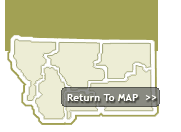

| Home | Communities | Accommodations | Places To Go | Things To Do | Site Map |
|
Glacier Country
Central Montana
Missouri River Country
Southwest Montana
Yellowstone Country
Southeast Montana
|

Libby DamLibby MontanaListing Type: DamCity: Libby Montana Region: Glacier Country 406-293-5577 http://www.nws.usace.army.mil/libby.cfm |  More Images |
Libby Dam is the culmination of years of effort on the part of both the United States and Canada to develop a flood control plan for the Columbia River basin. The Kootenai River is the third largest tributary of the Columbia River, contributing almost 20 percent of the total water in the lower Columbia. The dam stands 422 feet tall and about one-half mile long and creates a reservoir (Lake Koocanusa) which extends 42 miles into Canada. Construction began in 1966 and the dedication ceremony in 1975 marked the beginning of commercial power generation. The Columbia River Treaty was established between the governments of Canada and the United States before the dam was built. This treaty paved the way for cooperative development of the Columbia River basin while simultaneously aiding future negotiations between the two countries. Construction of the dam required relocation of about 60 miles of Burlington Northern's main railroad line and 52 miles of Montana State Highway 37, construction of 51 miles of Forest Service roads, and relocation or adjustment of other roads, facilities, utilities, and services effected by Lake Koocanusa. The town of Rexford was moved out of the lake area. In Canada there were effected communities, roads and railroad sections too. The railroad relocation required construction of a 7-mile long tunnel. The Flathead Tunnel is the world's 7th longest railroad tunnel. One of the most impressive features of the dam is the Treaty Tower which reaches 57.5 feet above the top of the dam It is distinguished by the 70-ton granite sculpture on its face. An international committee chose Albert Wein's design from a contest field of 250 entries. The sculpture symbolizes the natural and man-made forces on the Kootenai River, and commemorates the treaty between the two nations. The Souse Gulch Day Use Area is open daily after the first week of May. The day use area is located immediately adjacent to the Visitor Center. The picnic area contains 46 sites, restroom facilities, volleyball court, horseshoe pits and two playgrounds. There are three shelters available for group picnics. Each shelter has 4 tables, 2 cooking grills, 2 sinks with running water and electricity. Shelter reservations can be made by calling the Visitor Center at (406) 293-5577. Firewood for the picnic and shelter sites is provided. Reservations are required at least one day prior to use. The boat ramp and visitor parking are available year around. Libby Dam Visitor Center is a great place to visit with family and friends during the recreation season. It has a newly remodeled exhibit area, book/gift sales area and auditorium with movies on Libby Dam and the Columbia River system shown upon request. The displays include many interactive and hands-on experiences for young and old alike. Free guided tours of dam and powerhouse are offered Memorial Day weekend through Labor Day weekend daily (except Wednesdays) at 10:00am, 12:00pm, 2:00pm, and 4:00pm. Tours are first come, first serve and last about 90 minutes. Tours focus on the difficult task of balancing the missions of flood control, hydropower, fish and wildlife management and recreation at Libby Dam. Identification is required for visitors 18 and older. Large groups are asked to book tours at least 2 weeks in advance.
Directions: The Libby Dam Visitor Center is located on the west side of the dam and can be reached from the Forest Development Road (FDR) 228 or by turning off Montana State Highway 37 at the Jennings Hiline Road, follow this road down the hill, across the bridge below the dam and follow the signs to the Visitor Center.
Libby Dam
17115 Highway 37, Libby, MT 59923
|
A source for Montana Travel & Tourism Information
![]()